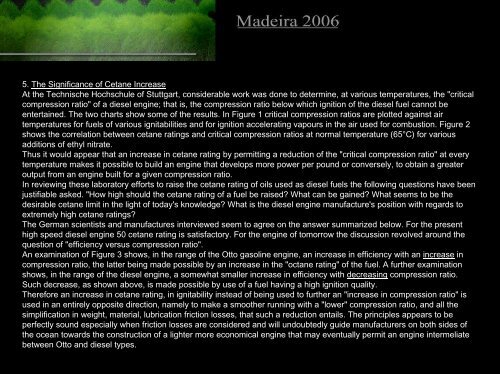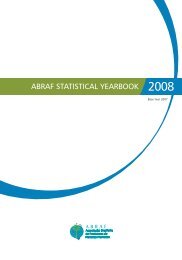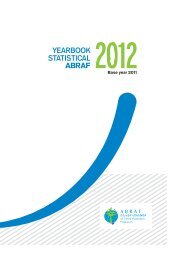Syngas - Associação Brasileira de Produtores de Florestas Plantadas
Syngas - Associação Brasileira de Produtores de Florestas Plantadas
Syngas - Associação Brasileira de Produtores de Florestas Plantadas
- No tags were found...
You also want an ePaper? Increase the reach of your titles
YUMPU automatically turns print PDFs into web optimized ePapers that Google loves.
5. The Significance of Cetane IncreaseAt the Technische Hochschule of Stuttgart, consi<strong>de</strong>rable work was done to <strong>de</strong>termine, at various temperatures, the "criticalcompression ratio" of a diesel engine; that is, the compression ratio below which ignition of the diesel fuel cannot beentertained. The two charts show some of the results. In Figure 1 critical compression ratios are plotted against airtemperatures for fuels of various ignitabilities and for ignition accelerating vapours in the air used for combustion. Figure 2shows the correlation between cetane ratings and critical compression ratios at normal temperature (65°C) for variousadditions of ethyl nitrate.Thus it would appear that an increase in cetane rating by permitting a reduction of the "critical compression ratio" at everytemperature makes it possible to build an engine that <strong>de</strong>velops more power per pound or conversely, to obtain a greateroutput from an engine built for a given compression ratio.In reviewing these laboratory efforts to raise the cetane rating of oils used as diesel fuels the following questions have beenjustifiable asked. "How high should the cetane rating of a fuel be raised? What can be gained? What seems to be the<strong>de</strong>sirable cetane limit in the light of today's knowledge? What is the diesel engine manufacture's position with regards toextremely high cetane ratings?The German scientists and manufactures interviewed seem to agree on the answer summarized below. For the presenthigh speed diesel engine 50 cetane rating is satisfactory. For the engine of tomorrow the discussion revolved around thequestion of "efficiency versus compression ratio".An examination of Figure 3 shows, in the range of the Otto gasoline engine, an increase in efficiency with an increase incompression ratio, the latter being ma<strong>de</strong> possible by an increase in the "octane rating" of the fuel. A further examinationshows, in the range of the diesel engine, a somewhat smaller increase in efficiency with <strong>de</strong>creasing compression ratio.Such <strong>de</strong>crease, as shown above, is ma<strong>de</strong> possible by use of a fuel having a high ignition quality.Therefore an increase in cetane rating, in ignitability instead of being used to further an "increase in compression ratio" isused in an entirely opposite direction, namely to make a smoother running with a "lower" compression ratio, and all thesimplification in weight, material, lubrication friction losses, that such a reduction entails. The principles appears to beperfectly sound especially when friction losses are consi<strong>de</strong>red and will undoubtedly gui<strong>de</strong> manufacturers on both si<strong>de</strong>s ofthe ocean towards the construction of a lighter more economical engine that may eventually permit an engine intermeliatebetween Otto and diesel types.
















